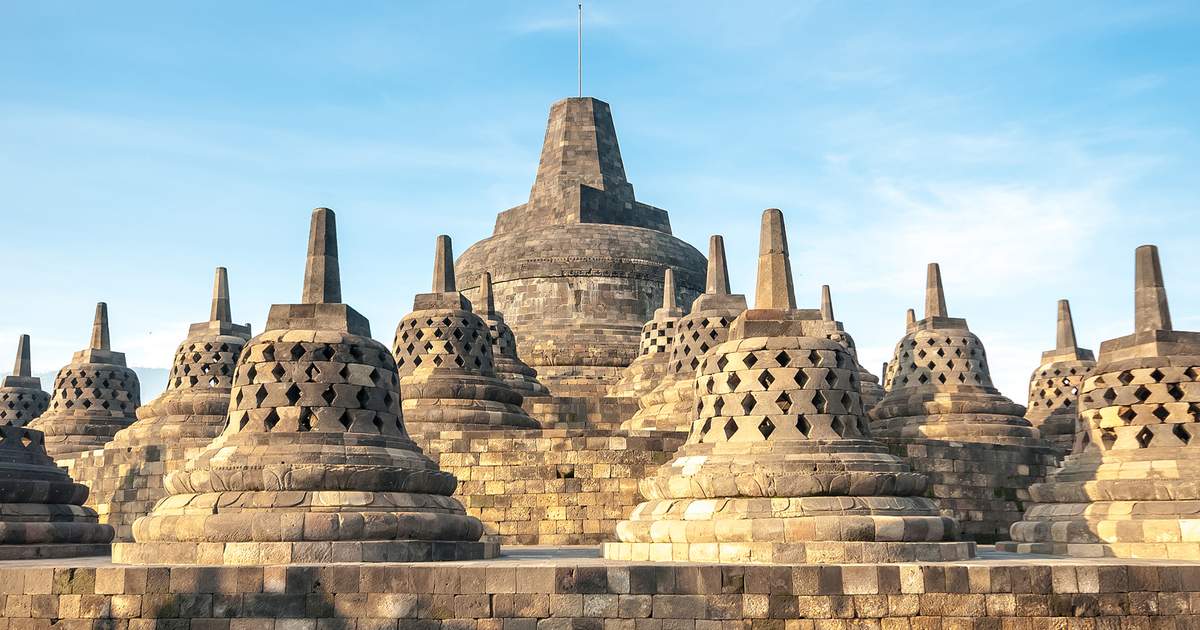Borobudur, situated on the Indonesian island of Java, is not just an ancient temple; it’s a testament to the grandeur of Buddhist culture and the architectural marvel of its time. This colossal temple complex is the world’s largest Buddhist temple and a UNESCO World Heritage Site. Let’s explore the history, significance, and beauty of Borobudur.

A Magnificent Masterpiece
Borobudur is an architectural masterpiece, consisting of nine stacked platforms, six square and three circular, adorned with 2,672 relief panels and 504 Buddha statues. Its sheer scale and artistic grandeur have earned it a place among the most remarkable monuments of the world.
A Glimpse into History
The temple’s construction began during the Sailendra dynasty in the 8th century, making it over 1,200 years old. The structure itself is a representation of the Buddhist cosmos, divided into three levels: Kamadhatu (the world of desire), Rupadhatu (the world of forms), and Arupadhatu (the world of formlessness). The entire temple is adorned with intricate carvings that tell stories from Buddhist cosmology and guide devotees along the path to enlightenment.
The Restoration
Borobudur was abandoned and buried under volcanic ash for centuries before being rediscovered in the 19th century. The Indonesian government, along with international organizations, initiated an extensive restoration project to rescue this architectural treasure. Today, it stands as a symbol of Indonesia’s dedication to preserving its cultural heritage.
A Sacred Pilgrimage Site
Borobudur is a significant pilgrimage site for Buddhists. Annually, on Vesak Day (a holiday observed by Buddhists to celebrate Buddha’s birth, enlightenment, and death), thousands of pilgrims from around the world flock to Borobudur. They walk a three-kilometer route from Mendut Temple to Borobudur, culminating in a candlelit procession within the temple’s compound.
The Borobudur Experience
Visiting Borobudur is not just an exploration of ancient architecture; it’s a spiritual journey. As you climb the temple’s terraces and study the intricate carvings, you’ll sense the temple’s spiritual significance. The view from the top is breathtaking, with the surrounding lush landscapes and distant volcanic mountains adding to the mystique.
UNESCO World Heritage
In 1991, Borobudur was designated a UNESCO World Heritage Site, recognizing its cultural and historical significance and the efforts to preserve it. It’s a testament to the importance of safeguarding our global heritage.
The Majestic Sunrise
For many visitors, witnessing the sunrise from Borobudur is a bucket-list experience. The temple opens early, allowing tourists to climb up and witness the sun’s first rays illuminate the structure, creating a mesmerizing sight. It’s a spiritual experience that lingers in the memory of all who are fortunate enough to behold it.
A Timeless Wonder
Borobudur, the world’s largest Buddhist temple, endures as an enduring symbol of Indonesia’s rich history, a testament to the power of preservation, and a reminder of the timeless appeal of spiritual exploration. Whether you’re an architecture enthusiast, a history buff, or a spiritual seeker. Borobudur’s awe-inspiring grandeur offers something to marvel at and appreciate.